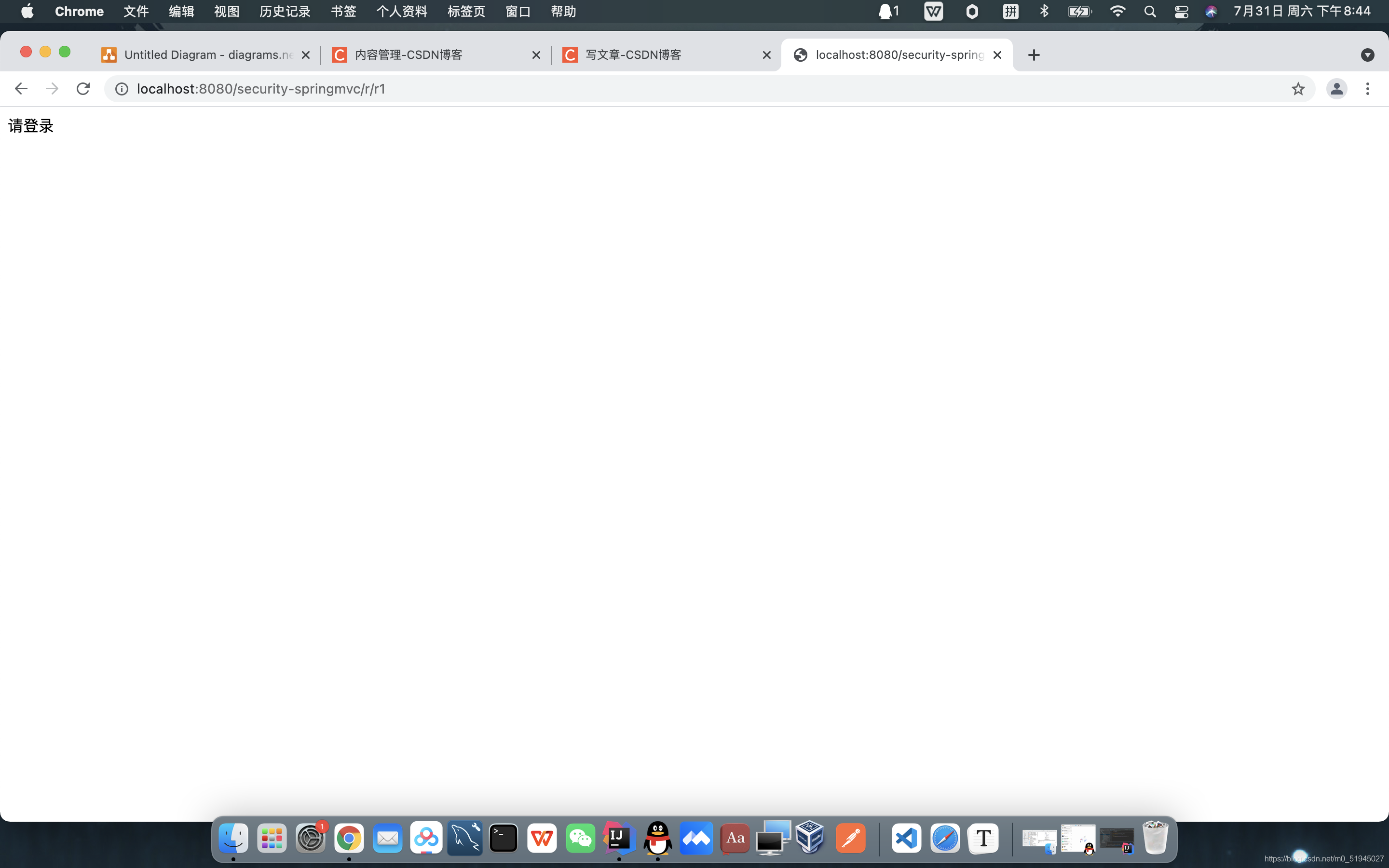现在我们已经完成了用户身份凭证的校验以及登录的状态保持,并且我们也知道了如何获取当前登录用户(从Session中获取)的信息,接下来,用户访问系统需要经过授权,即需要完成如下功能:
- 匿名用户(未登录用户)访问拦截:禁止匿名用户访问某些资源。
- 登录用户访问拦截:根据用户的权限决定是否能访问某些资源。
1、增加权限数据
为了实现这样的功能,我们需要在UserDto里增加权限属性,用于表示该登录用户所拥有的权限,同时修改 UserDto的构造方法。
package com.uncle.security.springmvc.model;
import lombok.AllArgsConstructor;
import lombok.Data;
import java.util.Set;
/**
* @program: security-springmvc
* @description:
* @author: 步尔斯特
* @create: 2021-07-22 23:25
*/
@Data
@AllArgsConstructor
public class UserDto {
public static final String SESSION_USER_KEY = "_user";
//用户身份信息
private String id;
private String username;
private String password;
private String fullname;
private String mobile;
/**
* 用户权限
*/
private Set<String> authorities;
}
并在AuthenticationServicelmpI中为模拟用户初始化权限,其中张三给了p1权限,李四给了p2权限。
package com.uncle.security.springmvc.service;
import com.uncle.security.springmvc.model.AuthenticationRequest;
import com.uncle.security.springmvc.model.UserDto;
import org.springframework.stereotype.Service;
import org.springframework.util.StringUtils;
import java.util.HashMap;
import java.util.HashSet;
import java.util.Map;
import java.util.Set;
/**
* @program: security-springmvc
* @description:
* @author: 步尔斯特
* @create: 2021-07-22 23:27
*/
@Service
public class AuthenticationServiceImpl implements AuthenticationService{
/**
* 用户认证,校验用户身份信息是否合法
*
* @param authenticationRequest 用户认证请求,账号和密码
* @return 认证成功的用户信息
*/
@Override
public UserDto authentication(AuthenticationRequest authenticationRequest) {
//校验参数是否为空
if(authenticationRequest == null
|| StringUtils.isEmpty(authenticationRequest.getUsername())
|| StringUtils.isEmpty(authenticationRequest.getPassword())){
throw new RuntimeException("账号和密码为空");
}
//根据账号去查询数据库,这里测试程序采用模拟方法
UserDto user = getUserDto(authenticationRequest.getUsername());
//判断用户是否为空
if(user == null){
throw new RuntimeException("查询不到该用户");
}
//校验密码
if(!authenticationRequest.getPassword().equals(user.getPassword())){
throw new RuntimeException("账号或密码错误");
}
//认证通过,返回用户身份信息
return user;
}
//根据账号查询用户信息
private UserDto getUserDto(String userName){
return userMap.get(userName);
}
//用户信息
private Map<String,UserDto> userMap = new HashMap<>();
{
Set<String> authorities1 = new HashSet<>();
authorities1.add("p1");//这个p1我们人为让它和/r/r1对应
Set<String> authorities2 = new HashSet<>();
authorities2.add("p2");//这个p2我们人为让它和/r/r2对应
userMap.put("zhangsan",new UserDto("1010","zhangsan","123","张三","133443",authorities1));
userMap.put("lisi",new UserDto("1011","lisi","456","李四","144553",authorities2));
}
}
2、增加测试资源
我们想实现针对不同的用户能访问不同的资源,前提是得有多个资源,因此在Logincontroller中增加测试资源2。
package com.uncle.security.springmvc.controller;
import com.uncle.security.springmvc.model.AuthenticationRequest;
import com.uncle.security.springmvc.model.UserDto;
import com.uncle.security.springmvc.service.AuthenticationService;
import org.springframework.beans.factory.annotation.Autowired;
import org.springframework.web.bind.annotation.GetMapping;
import org.springframework.web.bind.annotation.RequestMapping;
import org.springframework.web.bind.annotation.RestController;
import javax.servlet.http.HttpSession;
/**
* @program: security-springmvc
* @description:
* @author: 步尔斯特
* @create: 2021-07-22 23:33
*/
@RestController
public class LoginController {
@Autowired
AuthenticationService authenticationService;
@RequestMapping(value = "/login",produces = "text/plain;charset=utf-8")
public String login(AuthenticationRequest authenticationRequest, HttpSession session){
UserDto userDto = authenticationService.authentication(authenticationRequest);
//存入session
session.setAttribute(UserDto.SESSION_USER_KEY,userDto);
return userDto.getUsername() +"登录成功";
}
@GetMapping(value = "/logout",produces = {
"text/plain;charset=UTF-8"})
public String logout(HttpSession session){
session.invalidate();
return "退出成功";
}
@GetMapping(value = "/r/r1",produces = {
"text/plain;charset=UTF-8"})
public String r1(HttpSession session){
String fullname = null;
Object object = session.getAttribute(UserDto.SESSION_USER_KEY);
if(object == null){
fullname = "匿名";
}else{
UserDto userDto = (UserDto) object;
fullname = userDto.getFullname();
}
return fullname+"访问资源r1";
}
@GetMapping(value = "/r/r2",produces = {
"text/plain;charset=UTF-8"})
public String r2(HttpSession session){
String fullname = null;
Object userObj = session.getAttribute(UserDto.SESSION_USER_KEY);
if(userObj != null){
fullname = ((UserDto)userObj).getFullname();
}else{
fullname = "匿名";
}
return fullname + " 访问资源2";
}
}
3、实现授权拦截器
在interceptor包下定义SimpleAuthenticationlnterceptor拦截器,实现授权拦截:
- 校验用户是否登录
- 校验用户是否拥有操作权限
package com.uncle.security.springmvc.interceptor;
import com.uncle.security.springmvc.model.UserDto;
import org.springframework.stereotype.Component;
import org.springframework.web.servlet.HandlerInterceptor;
import javax.servlet.http.HttpServletRequest;
import javax.servlet.http.HttpServletResponse;
import java.io.IOException;
import java.io.PrintWriter;
/**
* @program: security-springmvc
* @description:
* @author: 步尔斯特
* @create: 2021-07-22 23:53
*/
@Component
public class SimpleAuthenticationInterceptor implements HandlerInterceptor {
@Override
public boolean preHandle(HttpServletRequest request, HttpServletResponse response, Object handler) throws Exception {
//在这个方法中校验用户请求的url是否在用户的权限范围内
//取出用户身份信息
Object object = request.getSession().getAttribute(UserDto.SESSION_USER_KEY);
if(object == null){
//没有认证,提示登录
writeContent(response,"请登录");
}
UserDto userDto = (UserDto) object;
//请求的url
String requestURI = request.getRequestURI();
if( userDto.getAuthorities().contains("p1") && requestURI.contains("/r/r1")){
return true;
}
if( userDto.getAuthorities().contains("p2") && requestURI.contains("/r/r2")){
return true;
}
writeContent(response,"没有权限,拒绝访问");
return false;
}
//响应信息给客户端
private void writeContent(HttpServletResponse response, String msg) throws IOException {
response.setContentType("text/html;charset=utf-8");
PrintWriter writer = response.getWriter();
writer.print(msg);
writer.close();
}
}
在WebConfig中配置拦截器,匹配/r/**的资源为受保护的系统资源,访问该资源的请求进入SimpleAuthenticationInterceptor 拦截器。
package com.uncle.security.springmvc.config;
import com.uncle.security.springmvc.interceptor.SimpleAuthenticationInterceptor;
import org.springframework.beans.factory.annotation.Autowired;
import org.springframework.context.annotation.Bean;
import org.springframework.context.annotation.ComponentScan;
import org.springframework.context.annotation.Configuration;
import org.springframework.context.annotation.FilterType;
import org.springframework.stereotype.Controller;
import org.springframework.web.servlet.config.annotation.EnableWebMvc;
import org.springframework.web.servlet.config.annotation.InterceptorRegistry;
import org.springframework.web.servlet.config.annotation.ViewControllerRegistry;
import org.springframework.web.servlet.config.annotation.WebMvcConfigurer;
import org.springframework.web.servlet.view.InternalResourceViewResolver;
/**
* @program: security-springmvc
* @description:
* @author: 步尔斯特
* @create: 2021-07-22 21:34
*/
@Configuration//就相当于springmvc.xml文件
@EnableWebMvc
@ComponentScan(basePackages = "com.uncle.security.springmvc"
,includeFilters = {
@ComponentScan.Filter(type = FilterType.ANNOTATION,value = Controller.class)})
public class WebConfig implements WebMvcConfigurer {
@Autowired
SimpleAuthenticationInterceptor simpleAuthenticationInterceptor;
//视频解析器
@Bean
public InternalResourceViewResolver viewResolver(){
InternalResourceViewResolver viewResolver = new InternalResourceViewResolver();
viewResolver.setPrefix("/WEB-INF/view/");
viewResolver.setSuffix(".jsp");
return viewResolver;
}
@Override
public void addViewControllers(ViewControllerRegistry registry) {
registry.addViewController("/").setViewName("login");
}
@Override
public void addInterceptors(InterceptorRegistry registry) {
registry.addInterceptor(simpleAuthenticationInterceptor).addPathPatterns("/r/**");
}
}
4、测试
未登录情况下,/r/r1与/r/r2均提示"请先登录
张三登录情况下,由于张三有p1权限,因此可以访问/r/r1 ,张三没有p2权限,访问/r/r2时提示"权限不足"。
同理,李四登录情况下,由于李四有p2权限,因此可以访问/r/r2,李四没有p1权限,访问/r/r1时提示"权限不足"。(图略过)
测试结果全部符合预期结果。
基于Session的认证方式是一种常见的认证方式,至今还有非常多的系统在使用。
我们在此使用Springmvc技术对它进行简单实现,旨在让大家更清晰实在的了解用户认证、授权以及会话的功能意义及实现套路,也就是它们分别干了哪些事儿?大概需要怎么做?而在正式生产项目中,我们往往会考虑使用第三方安全框架(如spring security ,shiro等安全框架)来实现认证授权功能,因为这样做能一定程度提高生产力,提高软件标准化程度,另外往往这些框架的可扩展性考虑的非常全面。
但是缺点也非常明显,这些通用化组件为了提高支持范围会增加很多可能我们不需要的功能,结构上也会比较抽象,如果我们不够了解它,一旦出现问题,将会很难定位。





